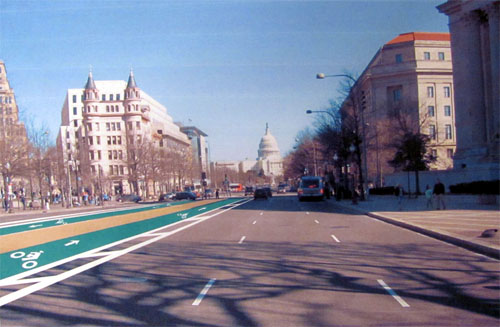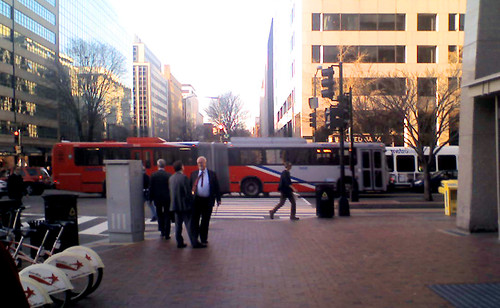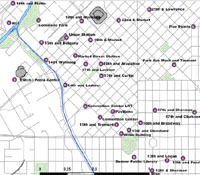|
Special Features





Image Libraries


|
|
Blog
|

Gehry’s proposed design. |
Earlier this morning I contributed to a Greater Greater Washington post about the proposed Eisenhower Memorial, designed by starchitect Frank Gehry. The GGW article was a group piece however, and while it included many of my thoughts, I wanted to expand some of my personal feelings here.
My overall impression of these initial images is that Gehry’s design is thoughtful and inoffensive, but also underwhelming. Gehry has always been a better sculptor than architect, and is usually at his best when designing things that aren’t traditional buildings, such as the Pritzker Pavilion. Memorials, unlike traditional work/live buildings, are great opportunities for sculpture, so I am disappointed to see one of the world’s great sculptors essentially punt.
The semi-circular inner plaza element is evocative of the FDR and MLK memorials, with its informal placement of decorated stone blocks. The look is attractive enough, but it’s beginning to be a cliche. In my opinion it’s the least ambitious part of the memorial, ironic considering it’s the focal point.
In any event, the restrained central plaza should present an interesting dichotomy to the much more formal and monumentally-sized outer elements, the cylinders and metal tapestries.
The cylinders do more than any other element to make the memorial visually striking from a distance, and so are indispensable to the design, but at 80 feet tall and lacking any details whatsoever they will be too bare up close. Like the lackluster inner plaza, the cylinders are a missed opportunity for sculpture. If I were the designer I might go classical, but Gehry could propose something like bareiss columns and that would be just as good.
I also have mixed feelings about the other major element of the memorial, the metal tapestries. I appreciate and agree with the desire to cover up the Education Department building, but to do so with oversized picture panels is a touch contrived – a little too easy. It’s like we’ve taken the tarps that are supposed to hide the parking garages at Nationals Ballpark and turned them into a monument. It’s a difficult problem, but is that *really* the best we can do?
Gehry deserves credit for restraining himself from retreading his own familiar shtick. Another mass of crumbled titanium would have been inappropriate; it would be memorial to Gehry himself more so than Eisenhower. But at the same time I have to say I’m disappointed that there’s nothing daring in this proposal. Such rare opportunities for artful civic sculpture shouldn’t be ignored. This memorial could be worse, but it could also be a lot better.
 Cross-posted at Greater Greater Washington. Cross-posted at Greater Greater Washington.
Average Rating: 4.5 out of 5 based on 168 user reviews.
March 26th, 2010 | Permalink
Tags: architecture

This is an easy one, so here you go.
Yesterday the US Census released its annual population estimates for counties and metropolitan areas for 2009. Listed below are the 10 largest Combined Statistical Areas, which along with MSAs and UAs are one of the three main measures of metropolitan population. Ryan Avent has a discussion going about the Census estimates.
| Rank |
Area |
Population |
| 1 |
New York-Newark-Bridgeport |
22, 232, 494 |
| 2 |
Los Angeles-Long Beach-Riverside |
17, 820, 893 |
| 3 |
Chicago-Naperville-Michigan City |
9, 804, 845 |
| 4 |
Washington-Baltimore-Northern Virginia |
8, 440, 617 |
| 5 |
Boston-Worcester-Manchester |
7, 609, 358 |
| 6 |
San Jose-San Francisco-Oakland |
7, 427, 757 |
| 7 |
Dallas-Fort Worth |
6, 805, 275 |
| 8 |
Philadelphia-Camden-Vineland |
6, 533, 122 |
| 9 |
Houston-Baytown-Huntsville |
5, 968, 586 |
| 10 |
Atlanta-Sandy Springs-Gainesville |
5, 831, 778 |
The next ten are (in order) Detroit, Seattle, Minneapolis, Denver, Saint Louis, Cleveland, Orlando, Pittsbugh, Sacramento, Charlotte.
Average Rating: 4.6 out of 5 based on 289 user reviews.
March 24th, 2010 | Permalink
Tags: top10

I’ve been ill a few days and have not spent much time online. Expect posts to be light (if at all) the rest of this week.
Average Rating: 4.5 out of 5 based on 205 user reviews.
March 24th, 2010 | Permalink
Tags: site

|

The face of evil, according to some people in Gaithersburg.
Photo by flickr user Baying Hound. |
Urban chickens are really, really great. They’re an essentially free, organic, and local source of food, fertilizer, and pest control. They eat cockroaches and mosquitos and in return give you an unending supply of eggs. It used to be everybody with a backyard kept a backyard chicken coop, and as word of their benefits gets around again, more and more people are starting up the old practice. It’s one of the best and easiest ways to go green.
Except, y’know, a lot of people think backyards should be reserved for perfectly manicured Kentucky Bluegrass and that actual nature, agriculture, or production shouldn’t come within several miles of their subdivision, for fear of what it might do to their property values.
More and more people in Gaithersburg are keeping backyard chickens, and as a result an increasing number of people are demanding the city put a stop to it. The city – Montgomery County’s long-time agricultural center – is officially considering a ban and will take up the issue at a public hearing on Monday.
Gaithersburg has the option of going green, or going NIMBY. Let’s hope they make the right decision.
 Cross-posted at Greater Greater Washington. Cross-posted at Greater Greater Washington.
Average Rating: 4.5 out of 5 based on 194 user reviews.
March 19th, 2010 | Permalink
Tags: environment, government

DDOT presented information about its ambitious plan for downtown cycle tracks last night. GGW has the low down.

Matt Johnson’s photo of a DDOT rendering of Pennsylvania Avenue.
Average Rating: 4.5 out of 5 based on 221 user reviews.
March 19th, 2010 | Permalink
Tags: bike, transportation

Do you notice anything unusual about the bus in this picture?

Photo taken with my cell phone camera at K Street and 17th, Wednesday evening.
Click image to enlarge. (link fixed)
There’s nothing particularly weird about the fact that it’s an articulated (accordion) bus; WMATA has lots of those. What’s weird is that this is an old bus with a very new paint scheme.
It’s clear from the profile that this bus is from either 1995 or 2002 (the last times WMATA bought articulated buses without fancy-looking sloped fronts), but is painted using the scheme that wasn’t introduced until 2008. Presumably this bus must have been overhauled and repainted, but why go to the trouble of repainting the whole thing instead of just touching up the old job? After all, most of the other 1995 and 2002 buses still have the same old red stripes on white livery.
Anybody know the story?
Average Rating: 4.4 out of 5 based on 285 user reviews.
March 17th, 2010 | Permalink
Tags: bus, transportation

The decennial US Census is one of the most important things the federal bureaucracy does. In addition to determining how many Congressional representatives everyone gets (or doesn’t), the demographic information gathered helps planning agencies know how and where to plan. The more any particular demographic is represented in the census, the more likely it is that demographic will be the beneficiary of public funds. Getting an accurate assessment of where funding is necessary is, therefore, a basic necessity of effective government. We can’t fund solutions to problems we don’t know exist.
That’s why it is counterproductive for anyone to ignore their census survey, especially minority groups who are already underrepresented. The only way to make your taxes work for you instead of somebody else is if the government knows you’re there.
It’s curious then, that the ostensibly libertarian (but not really) think tank CATO Institute is suggesting that its members fill our their Census forms incorrectly. Apparently CATO is unsatisfied with simply criticizing government effectiveness, and is now actively working to purposefully make it even more ineffective. I guess the best way to prove something is broken is to break it yourself.
But I digress.
The US Census is mailing out its decennial survey forms this week. Several DC-area residents have already got them. For goodness sake, fill them out and send them in!
Average Rating: 4.5 out of 5 based on 268 user reviews.
March 17th, 2010 | Permalink
Tags: government

There are three tiny islands in the Potomac River slightly upstream from Georgetown, called the Three Sisters. You can see them from the Key Bridge. They’re cursed.
The story goes something like this:
Prior to European contact, the Potomac River divided the territories of the Powhatan and Susquehannock nations. The Powhatans lived south of the river in what is now Virginia, while the Susquehannocks lived north of it in what is now Maryland. The two groups did not get along.
Late one night, three Powhatan sisters decided to sneak across into Susquhannock territory in order to avenge the deaths of their betrothed husbands-to-be, who had been killed in a battle earlier that day. As the three Powhatan sisters crossed the Potomac River in a canoe, monstrously strong wind and water currents swept down the river, causing the river to become uncrossable, and eventually drowning the girls. As they drowned they uttered a curse, that if they could not cross the river at that location, no one else ever would. The spot where the sisters drowned was hit by a fierce lighting storm, and then the three islands rose up from the river bottom to their present location.
Since that time, nobody has had any luck crossing the river near the Three Sisters.
- 1791: L’Enfant proposes a bridge at Three Sisters as part of his grand plan for Washington. Most of the plan goes forward, but not the bridge. L’Enfant himself dies bitter and broke.
- 1826: Georgetown city officials petition Congress to build a Three Sisters bridge in order to compete with the Chain Bridge further upriver. The petition is ignored.
- 1857: Plans are submitted to Congress for a suspension bridge at the Three Sisters. Before construction begins the Civil War breaks out, and the idea is abandoned.
- 1969: Construction begins for a Three Sisters bridge as part of the Eisenhower Interstate Highway system. The new bridge is just a steel skeleton in 1972 when a giant storm approaches the Potomac, with monstrously strong wind and water currents, and fierce lightning. The storm is much like the one that drowned the three Powhatan sisters centuries earlier. When the storm subsides, the framework for the new bridge is gone, disappeared into the river depths. By then, local interests opposed to the bridge all along won their battle, and a new bridge wasn’t built.
One curse, four complete failures. You decide.
For a more complete narrative of the curse story, read its chapter in It Happened In Washington, DC.
Average Rating: 4.5 out of 5 based on 237 user reviews.
March 16th, 2010 | Permalink
Tags: events, fun, history, roads/cars, transportation

Some critics of President Obama suggest that he hasn’t delivered the change on which his campaign ran. In some ways, that could be true. On the topic of transportation, however, his administration has been nothing short of transformative. The culture change at USDOT is significant. When the Republican Secretary of Transportation is saying things like this, the fact that there has been a shift cannot seriously be denied.
If only Congress would get on board, we could take the next step and codify multi-modalism into a genuinely progressive transportation bill.
Average Rating: 4.6 out of 5 based on 222 user reviews.
March 15th, 2010 | Permalink
Tags: government, The New America, transportation

|

Bike-sharing locations in downtown Denver.
Click map for larger pdf. |
SmartBike DC is the only operating bike-sharing system in the United States, but it won’t be much longer. Earlier this week Denver B-Cycle officially began accepting memberships, in anticipation of opening for business in late April. When it does open, Denver B-Cycle will be about five times larger than SmartBike DC: 500 bikes at 50 stations compared to 120 bikes at 10 stations. It will be, by far, the United States’ largest bike-sharing operation to date.
But 2010 is going to be a big year.
At some point this year:
- Nice Ride Minnesota will open in Minneapolis with 80 stations and 1, 000 bikes.
- Boston will launch a system with 290 stations and 2, 500 bikes
- DC and Arlington will, presumably, dramatically expand bike-sharing in the Washington region.
It’s too bad we locals won’t be setting the pace anymore, but this is really, really exciting stuff. Compared to the huge capital costs of road and transit projects, bike-sharing moves people practically for free, and no matter how many windshield perspective journalists say otherwise, lots of people will use it.
Keep your eyes open for news from DC and Arlington in the coming weeks/months. They’ve been negotiating how to move forward, and will hopefully be making an announcement soon.
Average Rating: 4.7 out of 5 based on 248 user reviews.
March 12th, 2010 | Permalink
Tags: bike, The New America, transportation

|
Media





Site
About BeyondDC
Archive 2003-06
Contact
Category Tags:
Partners
|

 Cross-posted at Greater Greater Washington.
Cross-posted at Greater Greater Washington.
















